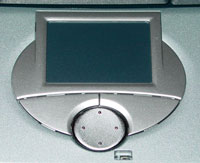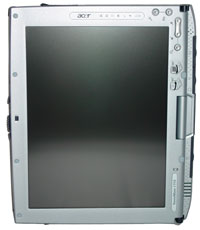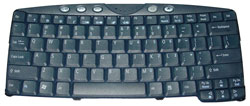Acer TravelMate C110: Centrino infused Tablet PC
by Andrew Ku on September 19, 2003 2:15 PM EST- Posted in
- Laptops
Construction — Build, Appearance, Size
In terms of convertible tablet PCs, the Toshiba Protégé 3500 tablet PC is actually more popular in the North American market, while overall, Acer has had some trouble in North America due to market strategy. This is apparent at most shopping outlets, including our own Price Check Engine. Though, we should note that the Acer TravelMate C100 was and still is the #1 tablet PC in EMEA (Europe, Middle East, and Africa).| Click to enlarge. |
Click to enlarge. |
In all respects, the TravelMate C110 looks very much like the C100, and follows the same general design. It is opened via a single sliding clip in the center of the system’s front. Just slide the clip to the left, open, and it appears in its notebook’s function.
Like most slate tablet PCs, the C110 line uses the standard 10.4" XGA LCD display, which can run at a maximum resolution of 1024x768x16. Considering that an ultraportable notebook uses a screen size of 12.1", the C110 is a bit physically challenged when it comes to performing as a notebook. It is suited fine as a tablet PC because most people will be holding it at a 1' distance from their face, which is about the optimal size to keep everything within eye range. When using a notebook, most people sit at about a 2' from their notebook display, and this may mean the C110’s 10.4" XGA LCD display is going to take some time to get use to.
When converting to tablet PC mode, you just need to unclip the two clips on the bottom far left and right of the LCD display. Then you just twist clockwise and fold the display back. After that, you just need to re-secure the clips and you find it in tablet PC mode. Acer recommends that you make sure the display is within 85° to 95° of the base of the unit before you make the transition to tablet PC mode. But this is just to avoid scraping the top of the keyboard. To get back to notebook mode, you go backwards, which is easy enough.
You may have already noticed that the clip to open the C110 is two-sided. By this, we mean that when you unclip the C110 in notebook mode, an identical secure hook appears on the top side of the display. This serves the purpose for automated orientation. When you switch to tablet PC mode and fold back the display, the hook on the top side of the display secures into the slot, which also closes in the notebook mode. There is a pressure point that detects when the hook secures, and this changes the display orientation from landscape to portrait. There is an immediate problem one notices: the stereo is covered by the tablet PC, and any sound is directed to the back of the display, which makes the sound muffled.
Click to enlarge.
The C110’s keyboard design has some give and take issues, as a result of the screen size. Overall, Acer has done a good job with the form of this convertible tablet PC. Given that the screen size is 10.4", the keyboard couldn’t be the size of what even ultraportable notebooks are touting. There are two factors that seem to make you sense that the keyboard is spaced too closely: key size and key font. Keys on the C110 are about one millimeter smaller, when compared to other similar keyboard layouts. As a spacing comparison, the IBM ThinkPad X31 has alphanumeric keys spaced 18.5mm (vertically) and 18.2mm (horizontally), and technically considered to be under a full sized keyboard’s specifications. Meanwhile, the C110 is spaced 17.5mm (vertically and horizontally). In addition, the low profile design of the keyboard reduces height/sloping and curvature of keys, even more so than on other similar notebooks designs. With the smaller keys, we found the markings use about the same size font, but don’t seem to use the bold type effect that we have seen on other similar keyboards. While the font issue plays more on the eyes, the low profile keyboard design C110 had very little tactile feedback. However, it seems Acer manages to still feature arrow keys. Though, they are multifunctional as controls for volume and brightness.

The touchpad, left and right mouse buttons, and a four-way internet scroll key are directly below the spacebar and to the right of the C110’s only speaker. The mouse buttons and the internet scroll key are made of a similar material as the casing, which leaves a bit to be desired in tactile feel. The four-way internet scroll key could specifically use some work by indenting the center/increasing curvature to get a more natural feel, which would be more preferable to four raised points.

When in either notebook or tablet PC mode, the C110’s display features buttons that enable certain functions outside of a keyboard. This is mandated by Microsoft, who certifies tablet PCs for use with their Windows XP tablet PC Edition. For purposes of explanation, we will stick with landscape orientation to describe the layout of the button locations. To the bottom and the right of the display, there are three buttons (starting from the right): round, down/left, and up/right. Their associated actions are Enter, Down, and Up, respectfully. On the right side near the bottom of the display, there are two buttons (from the top down), the Ctrl-Alt-Delete button and the Function button. Acer seems to have understood that too many additional buttons doing dedicated functions can create a layout problem where the user may mistakenly keep hitting buttons. In order to drain the most out of the few buttons, the Fn button, like on the keyboard, allows for other buttons to perform other actions: change orientation (Fn + up/right), escape (Fn + round), and tab (Fn + down/left). While these are the defaults, they can be changed to do a range of many actions.

Indicator lights on the C110 are located in two spots: one array of LED lights is on the front and the other on the back. The front LED status lights (from the top) reveals: number lock (green when on), caps lock (green when on), battery charge (orange when charging), media activity (green when accessing floppy, hard drive, or optical drive), sleep mode (orange in sleep mode), power (green while system is active), and Bluetooth/WLAN (red when either are active).

On the front, the color scheme is the same, but there are only three LED status lights (from the top): sleep mode, power, and Bluetooth/WLAN.
The long string of LEDs and buttons surround the 10.4" XGA LCD, which is electro magnetic according to the Microsoft Tablet PC specification. Again, we don’t know for certain if this is the same 10.4" display that was used in the previous tablet PCs we have seen, but we do know that the digitizer unit is. Like the Electrovaya Scribbler SC500 and the FIC SlateVision tablet PC, the C110 uses the Wacom 10.4" digitizer with a W8001 controller board, which we previously mentioned is capable of reporting 133 times per second with 256 levels of pressure resolution. For the C110, it is situated behind the left side of the 10.4" XGA LCD. This has basically become the standard for tablet PCs with electrostatic digitizers (for more information on the digitizer technology, read here). Briefly, digitizer technology just means that the screen is not touch sensitive, and the included stylus doesn’t have to touch the screen to move the cursor.
Since the C110 is a tablet PC, the screen is covered by a protective sheet of glass, which resists damage (cracking, scratching, etc.) and the generation of false colors due to acute pressure. The protective glass that covers the screen seems closer to that of the Electrovaya Scribbler SC500, because of its overall smoothness. The stylus didn’t glide aimlessly, but it could use some more texture to the screen surface; we should note that it would not reduce visibility.
The buttons and LEDs surround a 10.4" XGA LCD display that runs at 16-bit color. The screen, which is electro-magnetic according to the Microsoft Tablet PC specification, appears to be the same screen used in the FIC SlateVision. The screens have similar appearances, although the Scribbler SC500's screen did appear brighter than that of the pre-production SlateVision we looked at previously. Although we cannot know for certain that the 10.4" display in the Scribbler SC500 is the same as that used in the SlateVision, we do know that the digitizer units used in both are the same; something we will examine more once we take the unit apart. For now, just keep in mind that the screen is not touch sensitive. The included pen does not actually have to make contact with the screen to move the cursor (for more information on the digitizer technology, read here).













6 Comments
View All Comments
BlueFish - Wednesday, March 23, 2005 - link
Oh, one more thing to add. I asked the guy why should I bring it in, given that they had replaced the card. His response: "Maybe they replaced the wireless card with a faulty wireless card" - this was the reason for bringing it in so they could test it further. This is incredible! Acer support staff can do that? I'm guessing that their quality assurance processes must be horrible and that they can't even guarantee the wireless card is not faulty BEFORE you put it into a notebook!!!BlueFish - Wednesday, March 23, 2005 - link
I couldn't have made a bigger mistake. I was impressed by this unit. I totally bought the whole idea, tablet PC, small, light, tiny, hand recognition. What I got instead was wasted time, useless unit, horrible support and a real waste of money. Here goes a brief run down. If anybody from acer is reading this, you'd better get your act together, because stories like this only scare away consumers.1. Purchased the laptop in Jan (mid). Also purchased an external battery charger. Seemed like a good idea (given it came with 2).
2. Noticed that the laptop didn't shutdown well. Everytime I booted into the unit, it would hang, windows would go into grief and you needed to do it a few times before it decided to be useful.
3. Tried full system restore using Acer disks. Failed to be fixed.
4. Brought it into Acer's repair center. Wow, they guarentee 2 hour turn around. Only problem is, they're not quite in a convenient location. So it'll take you like 2 hours to get there and back anyway. Add it all up, that's 4 hours of wasted time. To top it all off, they are only open from 9 - 5. So what do they expect? customers to take time off work just to fix a stupid PC problem?
5. Got the unit back. Unit boots properly (yay).
6. Noticed the unit's Wireless IP stack keeps dumping. I'd drop a wireless connection many times and often just 5 mtrs away from a Netgear G wireless router. Rang Acer support - put on hold for 20 mins. Finally got through. Reported it and brought it back to the Acer repair center (again). Wasted another 4 hours.
7. Got a call to pick up the unit. Picked it up. The job form indicated they replaced the wireless card.
8. Got it that night and tried out the wireless. Same problem. Noticed that the problem occured depending on what software was running (seems very strange). This was MSN i was attempting to run and it caused the IP stack to dump! Discovered others are having this problem! Why didn't Acer support tell me of this?? instead of wasting my time. I'm a consultant and I hate to have to do these things because I'll have to make the hrs up later. Will Acer pay for my wasted time?
9. Called service support (again). Spoke to the support guy who wasn't very helpful, nor very sympathetic. Not even apologetic. He didn't even say sorry. What a bastard! I've had to waste almost 2 freekin working days and he didn't even have the courtesy to say sorry.
10. Worst still. I've discovered that the second battery they provided - which use to work - now doesn't even charge. I think it's the external charger. It's a bit flimsy in construction and could cause damage to the battery unit. I just tried the primary battery (the one that was working) and now it doesn't work. Probably because I used the external battery charger. Now I have two dud batteries. And to top it all off, you can't even use direct AC power (ie. run the laptop without a working battery). So if one day, the battery dies, forget using the power adaptor cos the unit's dead.
11. Service support said to bring it in again to the Acer support center to have a look again. I asked whether they were willing to replace the entire unit - no answer. The helpdesk guy IGNORED me. Asked if they were going to pickup and deliver they said no. So I have to waste another 4 hours to fix the unit, with no guarantees that after that it will be fixed. Asked for a total refund, they said no.
Am I wrong to expect so much from Acer? I don't think so. If I pay peanuts for something, I would expect peanuts. I'd say, "fair enough, it was cheep anyway. I can get another one... easy no fuss". But I paid AUD $3,700 for this product - an easy price for a plasma TV or LCD TV and now have incurred the following charges:
1. Transport charges to the service center (say 80 bucks)
2. Wasted time waiting and travelling (Say 1000 a day as a consultant) - 16 hours.
If you are looking for a good laptop - stay away from anybody who cannot deliver. Especially stay away unless they have the following:
1. Pickup and delivery of the laptop.
2. Willingness to stand behind their product
3. Renown product support.
Forget Acer's 2 hour guarantee. It's not much considering they don't pickup. You waste time doing all of that. And to sit there and wait 2 hours... forget it.
Acer - fix your products and do some real testing of them. Until then, everybody else, stay away from this pathetic, useless, counter productive vendor - you'll be a happier man/woman.
tomaal - Sunday, December 12, 2004 - link
so what are these rubber bits on the side of the monitor? I thought they might be some kind of speaker mounts, but I cant find any. Are they just bumpers to protect it?Andrew Ku - Thursday, October 23, 2003 - link
Nope it isn't bud. Check again. That isn't a true convertible notebook. It is just a slate with the ability to attach a keyboard.Anonymous User - Saturday, September 20, 2003 - link
Umm, you are forgetting the Compaq Tablet PC which is also a convertible.Poopship - Tuesday, December 18, 2012 - link
Gross